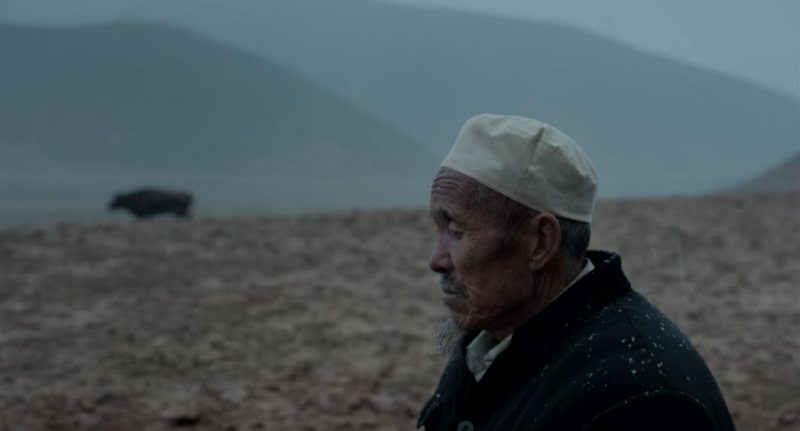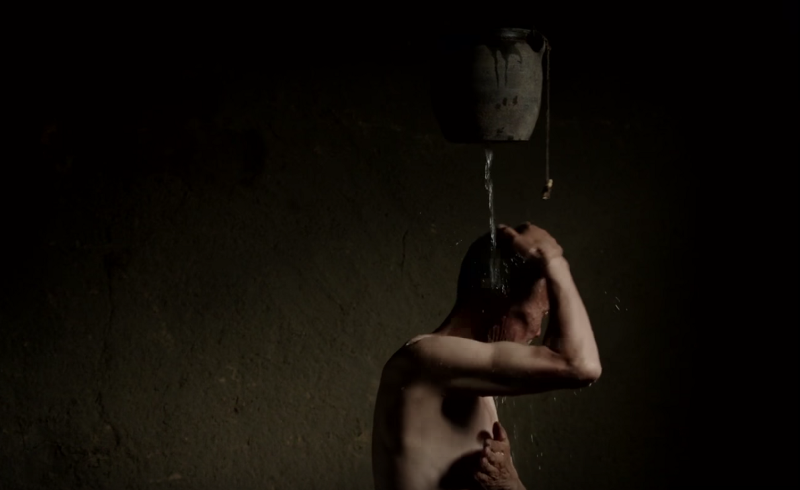It begins, as everything must, with a memory. A woman in a white headscarf stoops on a barren plain, the grass so sparse it could disappear with the next gust. From this distance, she has no face, no features to distinguish her from her shadow. An abstract column of dark cloth billows against the fog, grass, and sky. The blocky aspect ratio and blue wash build your sense of nostalgia and jamais vu; you understand it is twilight in winter. She stands, the shot cuts. The memory is over.
So ends the only flashback in Knife in the Clear Water, the formal, auteurist debut of emerging director-producer Wang Xuebo. The film is deeply concerned with lives on the verge of disappearing into the past, dislodged from their traditions by migration, poverty, and modernization. Ma Zishan, played by Yang Shengcang, is an elderly farmer and a respected figure in his rural Hui community. Following his wife’s death, Ma is exhorted by his son, imam, and community to offer his only bull for a ritual sacrifice. What follows is a meditative and at times bitterly weary confrontation of mortality that skirts the unclear line between acceptance and resignation.
Wang Xuebo is no stranger to the outskirts. His previous work includes The Hammer and Sickle are Sleeping, a collaboration with independent director Geng Jun, who would go on to craft the urban apocalyptic comedy Free + Easy, as well as Tharlo, a beatnik breakdown on the collision between urban and rural life in Tibet. The difference in Knife is its tone, which is relentlessly severe in its formality. Shots are long and dialogue is sparse yet portentous, able to communicate grudges and desires in the space of a few words. Camera movement is limited to short tracking, preferring to dwell on facial expressions, the movements of sheep or chickens, or spontaneous frames: clay doorways, windows, a ring of hills. At times, the effect is monotonous: one scene has the audience watch a goatherd refill several water troughs for about a minute and a half for no apparent reason. At others, clever blocking and camera work allow the audience to track several conversations and planes of action at once, conjuring Citizen Kane or Seven Samurai. One contiguous, two minute scene has Ma’s grandchildren chasing a chicken around their house, Ma and his son investigating a dry well, and Ma’s daughter-in-law watering and grooming their bull in one tranquil, bucolic sequence.

However, what allows Knife to attain its full aesthetic power is Ma’s masterful use of limited colors with a flexible temperature range. Dull white, dusty browns, and cold blues and greens characterize daytime scenes, which dominate the majority of the film. In stark contrast, night scenes are awash in warm, homely oranges. Combined with Wang’s love of wide shots and his limited aspect ratio, the scenes start to bear similarity with living oil paintings. Domestic scenes bring forth Johannes Vermeer, evening illuminations call upon the religious Baroque, the harsh pastoralism recalls Jean-François Millet. Wang has worked some magic onto the skins of his characters. They glow and breathe, bestowing a sacred aura onto their owners.
The film’s artistry and slow pace would be meaninglessly esoteric without an emotional center to hold it together. Yang Shengcang’s portrayal of Ma is a measured, powerhouse performance that anchors the film’s otherwise inaccessible stringency. His eyes, wrinkled face, and ascetic physique are the bedrock upon which he bears torrential emotion in silence. In a film entirely devoid of laughter, a scene where Ma’s eyes sparkle while he asks for a “proper gravesite” is a brief flare of good nature and whimsy. The absence of sobs and tears throughout the film does not matter; Ma’s bowed head is more than enough to communicate his shame and doubt as he refuses to respond to his son’s request for ceremony preparations. Nowhere is his talent more visible than in the showering scene. A naked Ma is placed against a bare wall with nothing else in the shot but a dangled pail of dripping water. What follows is a hypnotic choreography of contortions, wipes, and caresses to the percussive retorts of droplets against a concrete floor. This scene alone makes the film worth watching.

Ma serves as a medium through which Wang communicates his observations of a vanishing community. Ma’s son lives in the city, and will soon leave Ma alone in his house after the grieving ceremonies are over, another pilgrim in the march toward urbanization. Short vignettes, including Ma’s repayment of his wife’s debts to a niece and a rice loan given to a stricken brother-in-law, gesture at widespread rural poverty. Drought comes up repeatedly in characters’ conversations, the specter of industrial agriculture’s abandonment of rural farmers. Ma’s struggles with his faith, characterized by a troubled visit to his imam, speak not only to his grief, but the struggles of maintaining faith in a nation that has largely either overlooked or cracked down upon its Muslim populations. We read the wrinkles carved into his face as hieroglyphs from a foregone life, soon to be illegible to the modern world.
Death and disappearance are indeed the film’s true subjects. Fog, rain, and mud constantly threaten to swallow characters whole. When characters move out of frame, Wang treats us to an uncomfortable silence with no assurance that anyone will return. Ma’s bull simultaneously embodies both vibrant life and looming obliteration. In one scene, an orange lamp might light up the bull’s thick hair and make its stable appear as a shrine. In another, the bull’s black silhouette roams in the background as Ma ponders his future. Wang’s vision is of a China detached and drifting into invisibility, saturated with questions and doubts about a modernization leaving behind the laborers without whom it would have sputtered and failed.
Knife in the Clear Water is an aesthetic achievement, combining disparate elements from painting and cinema to craft a unique visual experience. Its severe tone and glacial pace are not for everyone, and should be avoided by those needing any satisfactory plot resolution. Yet for those curious for a stirringly cinematic insight into China’s own flyover regions and hidden struggles, this film will serve as testimony, a bulwark against dissipation. A funeral procession moves against a herd of sheep, an old man pauses to ensure that a baby lamb makes it safely up a slope. A woman stands upright despite her birthing pains. A gravestone becomes sanctuary. They find grace in the death throes, and brace firmly against the encroaching fog.

Comments powered by Talkyard.